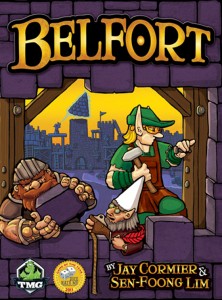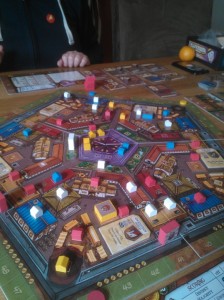 Worker management board games are something I quite enjoy but sometimes they can be a bit too heavy on the rules. If the first game doesn’t bed in the basic rules then the game has, in my opinion, too many rules. A worker management game has a greater learning curve than most board game styles and it needs an associated level of ease in the ability to understand the rules and run the game through the instruction book. I suspect someone with a maths degree, or a better understanding of algebra, can probably work out a graph of the relationship between the length of time a game should take against the ease at which you should be able to follow the instructions.
Worker management board games are something I quite enjoy but sometimes they can be a bit too heavy on the rules. If the first game doesn’t bed in the basic rules then the game has, in my opinion, too many rules. A worker management game has a greater learning curve than most board game styles and it needs an associated level of ease in the ability to understand the rules and run the game through the instruction book. I suspect someone with a maths degree, or a better understanding of algebra, can probably work out a graph of the relationship between the length of time a game should take against the ease at which you should be able to follow the instructions.
The Manhattan Project is a great game but it’s let down by the overly difficult instruction book. With a worker management game you need a book that is going to take you through each step and for the first game it should almost hold your hand as you go through the steps. The Manhattan Project gives you lots of options and tells you how to complete each one but it never gives you the bigger picture – it doesn’t tell you why you should do something or what you, as the player, gain from the move the book is explaining. This brings us round to the new game of the weekend, Belfort.
The town of Belfort is inhabited by Gnomes, Elves and Dwarves. It’s undergoing rapid expansion and you have been hired as a building manager. The only problem is four other managers have been hired as well and the town only has room for one of you. Resource gathering of wood, metal and stone plays a large part in the game as does coin collection, tax paying and the actual building of the properties. There are guilds in the town which can offer you special benefits like extra resources, and building the properties gives you benefits too such as extra income.

There are three scoring rounds in the game during which you gain points for having the most built properties in the five districts of the town and the most elves, dwarves and gnomes. However, bear in mind the more points you gain the higher taxes you have to pay – this adds an extra strategic element to the game. There are seven rounds in the game and in each round you place your gnomes and dwarves, collect resources and build properties, in that order.
The build quality of the game is very good with nicely cut wooden counters representing the wood, stone and metal resources plus the playing pieces around the scoring track and the small buildings representing properties you’ve built. The art for the game board, players boards, resource board and trading post board is exceptional and it’s very useful to have the five steps of each round printed on the players board too, along with a description of what you can do in each part.
It’s a great game, much more fun to play than some other worker management games. It’s worth having more than two at the table but the game does have some changes for less than three players that make it good fun. So far it’s one of the more enjoyable worker management games I’ve played. If it’s not on your list yet, then I thoroughly recommend you add it.
You can grab Belfort from your local stockist or online via many retailers. We prefer Eclectic Games in Reading. You can read more about Belfort on BoardGameGeek.com